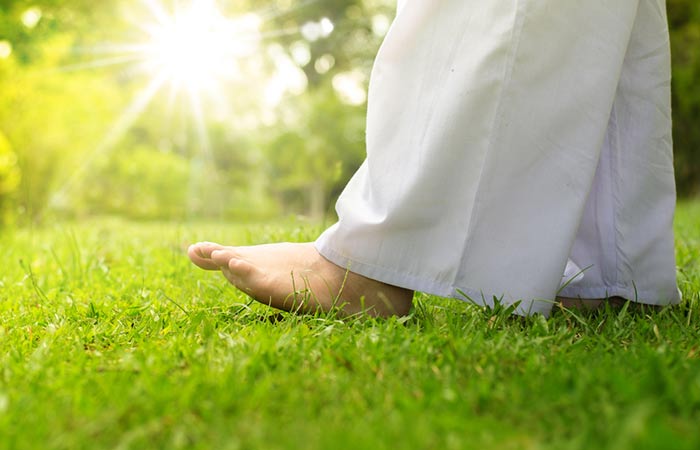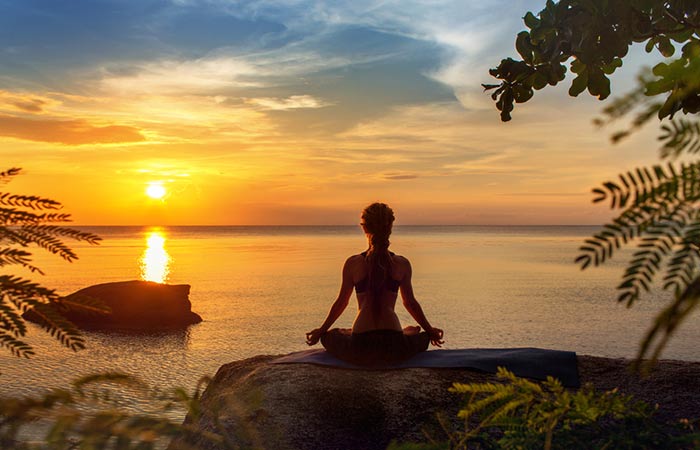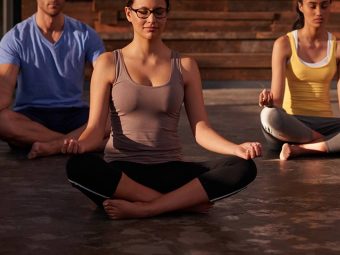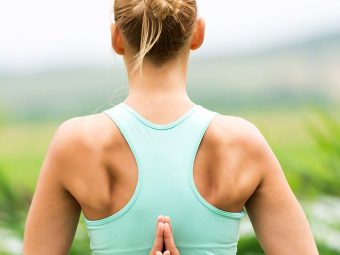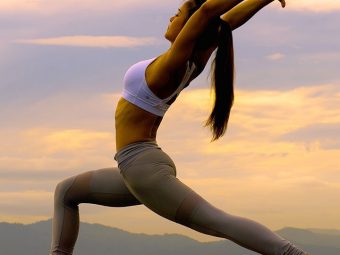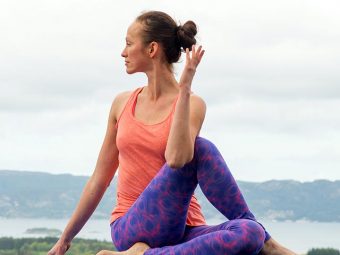What Is The Best Time To Do Yoga?
Get the most out of yoga by practicing it at the best time to elevate your spiritual being.

Image: Shutterstock
We rarely talk about the best time to practice yoga, although we know how magical this ancient form is. Also, how long you practice yoga has a significant impact on its effectiveness.
Have you ever wondered why yoga shows are frequently broadcast in the morning? There has to be a reason, and there is one. In this article, we have explained the right time to practice yoga to derive the maximum benefit. Take a look.
 Did You Know?
Did You Know?In This Article
What Is Yoga?
Yoga is a holistic discipline that originated in ancient India and focuses on harmonizing the mind, body, and spirit. It is an amalgamation of physical postures or poses (asanas), breathing exercises (pranayama), and meditation techniques to promote overall well-being. The word ‘yoga’ means union of individual consciousness with universal consciousness. Yoga cultivates physical strength, flexibility, and balance while improving mental clarity and emotional stability. Through mindful breathing and meditation, people reduce stress and anxiety to attain inner peace and mindfulness. Moreover, yoga encourages self-awareness, fostering a deep connection between the body, mind, and soul. It is not only a form of exercise but a way of life, promoting relaxation, spiritual growth, and a sense of inner harmony. With various styles and approaches, yoga is accessible to people of all ages and fitness levels, making it a versatile practice for holistic health.
Now that you know what yoga is, let’s understand when to practice yoga!
When To Practice Yoga?
The day is divided into four parts in the yogic science. They are the Brahma Muhurta, Sunrise, Noon, and Sunset.
If you want to practice yoga as a means to elevate your spiritual being, Brahma Muhurta is the perfect time to practice. But, if you are only looking at physical well-being, sunrise time or sunset time will do.
Noon is not recommended as it is meal time and your body needs a gap of at least 4 to 6 hours after eating to practice yoga so that the food gets digested by then and expends energy. Also, you may sweat more during the noon hour because of the heat, which could dehydrate your body.
So, ideally, Brahma Muhurta would be the best time to practice yoga, but it is better to choose a time that is convenient for you rather than being rigid. What is more important is to procure the best from each yoga session and try out different techniques to enhance your experience.
Asanas can be practiced either in the morning or evening on an empty stomach, but be careful not to practice challenging asanas that energize you just before bedtime. It might be ideal to practice all asanas in the morning to loosen and energize your body.
Pranayama, like asanas, can be practiced in the morning or evening, but best to not practice pranayama within two to four hours after a meal. Pranayama is a great way to energize the body through breathing.
You can practice meditation at any time of the day, ideally when you are not sleepy, drinking alcohol, or feeling hyper. An awake and relaxed state of mind is an excellent opportunity to meditate. Also, wait for two hours after having a meal to meditate to avoid feeling drowsy.
Yoga Nidra can be practiced any time of the day, even immediately after meals as long as you don’t fall asleep while you are at it.
According to the CDC, the use of yoga has become extremely popular in the US in 2017. Yoga practice and performance among U.S. adults aged 18-44 (17.9%) was more compared to those aged 65 years and above (6.7%). It was also noted that non-Hispanic white adults (17.1%) were more likely to practice yoga than Hispanic (8%) and non-Hispanic black adults (9.3%).
What Is The Best Time To Practice Yoga?
Sunrise is the best time to practice yoga. Brahma Muhurta, which is 3:40 am, is not a practical option for a lot of us. Therefore, according to experts, sunrise time is ideal and practical.
Similar to how you start your day with coffee or tea, start it with yoga, making it a regular morning practice. Breathing in the fresh air in the morning is ideal and helps you prepare for the challenges of the day ahead. What’s best about a morning yoga routine is that you get an energy boost that Wno coffee or tea can beat.
While the poses activate you and make you flexible for the day, yogic breathing stimulates, clears, and energizes your mind. It also keeps you fresh and rejuvenated. Yoga practice in the morning will keep you balanced and help you to calmly manage traffic jams, busy work schedules, and household chores.
Once you wake up, it’s best to empty your bowels, brush your teeth and start practicing. This way, you are less likely to skip the practice or feel too tired to do it later in the day
Mornings are when your muscles and joints are the stiffest. Yoga stretches and adds flexibility to them, thus helping you be on your toes throughout the day with ease.
Practicing yoga early in the morning is an excellent way to refresh your mind and spirit and get ready to take on the challenges of the day. It will ultimately awaken you and make you embrace the vibrancy of the day.
Also, sweat production is low in the mornings, preventing dehydration.
With so many advantages attached to it, no wonder a lot of traditions consider morning time as sacred.
Now, let’s learn the aspects that work best for a wholesome and holistic yoga experience.
Manner Of Yoga Practice For Best Results
1. Timing
As we discussed, mornings are the best. Sunrise time is specifically recommended. Between 5 am to 7 am in the morning is best. This is when you feel active, and the air is fresh.
Patrick Parker, a martial arts teacher and blogger, shares his experience of morning and evening workout sessions. He mentions that he considers himself as a non-morning person and he says, “I do notice in yoga that mental and physical readiness are often opposite biorhythms. Maybe that’s part of what makes yoga such a good morning thing for me – it seems to bring my sense of mental and physical wellbeing back toward the same rhythm (i).”
2. Place Of Practice
Choose a place that is clean and peaceful. It could be in your home or outdoors, like in a park, or even a yoga space. Make sure you are comfortable in the space and can completely focus on your practice.
Avoid practicing yoga in direct sunlight, cold wind, or a place with many insects that could distract you from the practice
3. Yoga Accessories
Accessories will make your practice smooth and more comfortable. Get yourself a nice yoga mat that enables you to practice poses as well as meditate comfortably.
A few other equipment like blocks, belts, cushions, and blankets help you ease into the poses better. These come in handy for beginners, the elderly, and those with physical problems.
4. Clothing
Make sure you wear medium fit and comfortable clothing that does not restrict your movement and help you move easily.
Remove any accessories from your body like glasses, watches, and jewelry.
5. Sequence Order
Begin with asanas, followed by Pranayama and meditation. The order is to prepare your body for meditation. Asanas prepare you physically, and Pranayama prepares you mentally for meditation. The awareness with each step increases, helping you meditate more effectively.
Cautions
Depending on the age and ability of the practitioner, individual yoga practice must be designed for the individual. Following a standard yoga format is not recommended without consultation.
Being able to practice yoga daily is ideal. But how? Following the above tips may help. Get started today and start feeling the benefits of yoga!
Let’s now answer some common queries on yoga.
Infographic: Yoga: Dos and Don’ts
Practicing yoga is an ideal way to stay fit and relax your body and mind. However, there are certain rules you need to follow before getting started with a yogic session. The following infographic deals with several dos and don’ts you must pay heed to for achieving the desired results and avoiding injuring yourself. Illustration: StyleCraze Design Team
Save the high-quality PDF version on your device now.
Download Infographic
 Quick Tip
Quick TipIn yogic science, sunrise, noon, and sunset are considered the Brahma Muhurtas. They are the best time to do yoga if you wish to elevate your spiritual being. However, if you are solely concerned with your bodily well-being, practicing at sunrise or sunset is your best option. Moreover, you should practice yoga every day and follow the strategies and techniques mentioned above to yield maximum benefits. You can also make the necessary adjustments in your practice to get the most out of it. Take a chance!
Frequently Asked Questions
How long do I practice yoga?
Whether it’s 20 minutes or an hour, moving the body through a yoga sequence is beneficial.
How often do I practice yoga?
Practice yoga every day if possible or at least three times a week.
Can practicing yoga at different times of the day impact digestion and metabolism?
Yes, the time of the day you practice yoga can affect your body’s natural rhythm and processes like digestion. Practicing yoga in the morning can help jumpstart your metabolism and stimulate your digestive system, while at night, it helps relax the body.
Is there a difference between practicing yoga in the morning or at night for individuals who are prone to anxiety or depression?
Yes, the early morning hours are quiet and serene, which helps provide a peaceful atmosphere that allows for a focused and mindful yoga session. Practicing yoga in the morning can help set a positive tone for the day, reduce stress, and make you feel energized and ready for the day. On the other hand, doing yoga at night helps to promote relaxation, peace, and a calm state of mind which can improve sleep quality. So it is important to listen to your body and its needs and choose the time that works for you.
How does the timing of yoga practice impact one’s motivation and adherence to a yoga practice routine?
Always choose a time that fits your daily routine as it will keep you motivated and adhere to yoga. If you choose a time that you know is difficult to adhere to, you will probably find excuses to skip it.
Key Takeaways
- The right time for yoga is a subjective matter that depends on personal preference and schedule.
- Early morning is considered to be the best time for yoga as it prepares you for the day.
- Practicing yoga at night can help reduce anxiety and sleep better.
- A consistent routine should be followed on a regular schedule.
- It is advisable to avoid heavy meals before yoga. Practicing on an empty stomach is more beneficial.
Start your yoga journey today! Learn the best time to do yoga and get tips on how to begin from this informative video. Get ready to feel energized and relaxed!
Personal Experience: Source
i. Working out in the morning vs. evening
https://mokurendojo.blogspot.com/2010/02/working-out-in-morning-vs-evening.html








